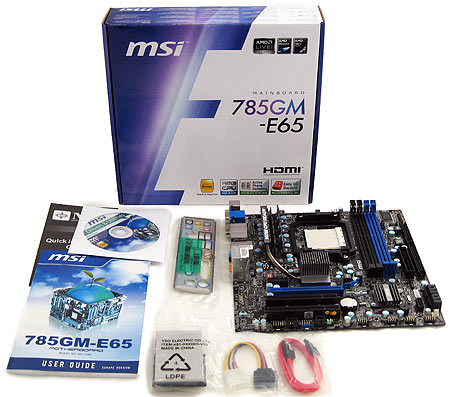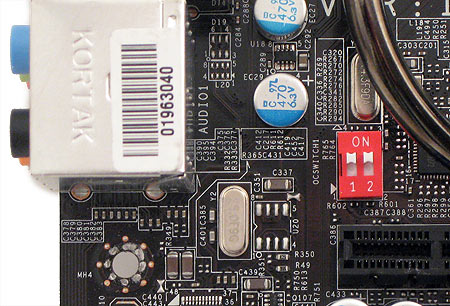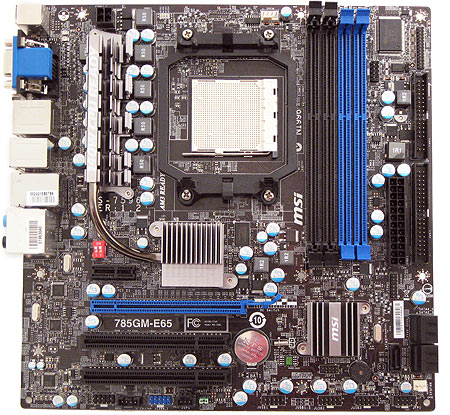Seven AMD 785G-Based Motherboards Rounded Up
MSI 785GM-E65: Features And Hardware
The MSI 785GM-E65 has some nice features. In fact, it's arguably the most fully-featured board in the roundup, even though its size is limited to the smaller microATX form factor. It matches the larger full-ATX Gigabyte board for capabilities, and while it has fewer PCI and PCIe slots, it offers some things that the Gigabyte board does not, like an eSATA port and 128MB of SidePort memory.
In contrast, the 785GM-E65's bundle isn't all that extensive. It consists of manuals, a driver CD, an I/O shield, a single SATA cable, an IDE cable, and a Molex-to-SATA power adapter.
Other features include Active Phase Switching (an AM2+/AM3 feature that disables extra power phases under light loads to save enegy) and Easy OC switch (an on-board switch to set a 10%, 15%, or 20% reference clock overclock without having to enter the BIOS).
While there's only a single 16-lane PCIe 2.0 slot and a single x1 PCIe slot, there are two legacy PCI slots. Everything else is accounted for with two FireWire ports (one internal), internal serial and parallel connectors, floppy and IDE ports, and six SATA ports (one is an external eSATA port). The MSI board also sports Realtek's premium ALC889 audio codec.
The board is well laid out, with connectors and sockets smartly placed along the edges where they belong. The 24-pin ATX power plug is centrally located, and even the floppy and IDE ports are on the correct side of the board. The SATA ports face to the right of the board, but even here MSI has supplied a single easy-to-get-to port, and it can hardly be blamed for trying to save some space on such a small form factor when so many options are included.
Get Tom's Hardware's best news and in-depth reviews, straight to your inbox.
Current page: MSI 785GM-E65: Features And Hardware
Prev Page ECS A785GM-M: BIOS And Overclocking Next Page MSI 785GM-E65: BIOS And OverclockingDon Woligroski was a former senior hardware editor for Tom's Hardware. He has covered a wide range of PC hardware topics, including CPUs, GPUs, system building, and emerging technologies.
-
JohnnyLucky Very informative article. Nice to see there are motherboards with different features for different users/tasks.Reply -
bpdski Great article, I think this shows pretty conclusively that there is no benefit to upgrading to an AM3 based system. If you already have an AM2+ system, you can easily just drop in a new CPU and you system will be every bit as good as a brand new system with DDR3. You just need to make sure your motherboard supports the power requirements of whatever you want to drop in.Reply -
jonpaul37 Hooray AMD for having cheap solutions in these hard-economic times!Reply
Boo @ Intel! i like the product, but my wallet & Girl do not like the cost! -
jonpaul37Hooray AMD for having cheap solutions in these hard-economic times!Boo @ Intel! i like the product, but my wallet & Girl do not like the cost!+1Reply
Girl has more money for clothes! -
ominous prime Well bpdski there is no point upgrading if you're AM2, but if you're building a new PC AM3 is the way to go in terms of your computers longevity. Very informative article.Reply -
sonofliberty08 thanks alot for the info , my first choice was allways asus , but now i now what i need when im going to unlock core , and now i saw the benefits of sideport memory .Reply -
duzcizgi ReplyWe were successful in achieving a 900 MHz stable overclock with the integrated graphics chipset by setting the BIOS to increase northbridge voltage by +.210mV.
Well, .210 mV = 210 microvolt. I don't think it would make much of a change. Maybe it is 210 mV or, .210 V. :) -
doron "Now we're seeing another benefit for the AM2+/DDR2 boards: both the Foxconn Cinema Premium and Biostar TA785GE 128M are drawing less power than their AM3/DDR3 counterparts."Reply
How comes? Didn't we all agree a long time ago that ddr3 supposed to be more energy efficient out of the two? (Lower voltage and stuff?) -
DarkMantle Great article, this will help a lot of people to make their AMD budget motherboard choice easier, thank you Don.Reply


